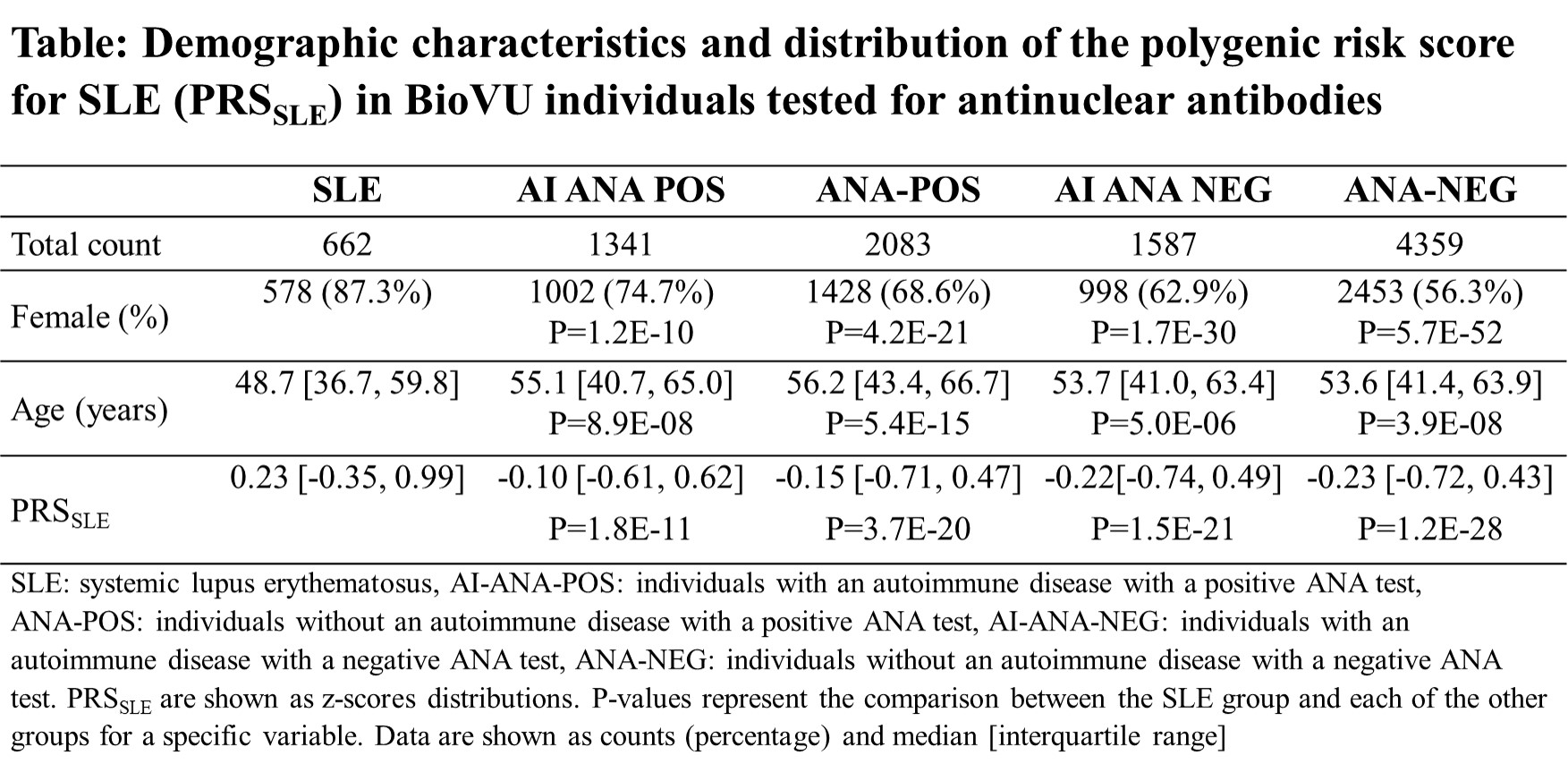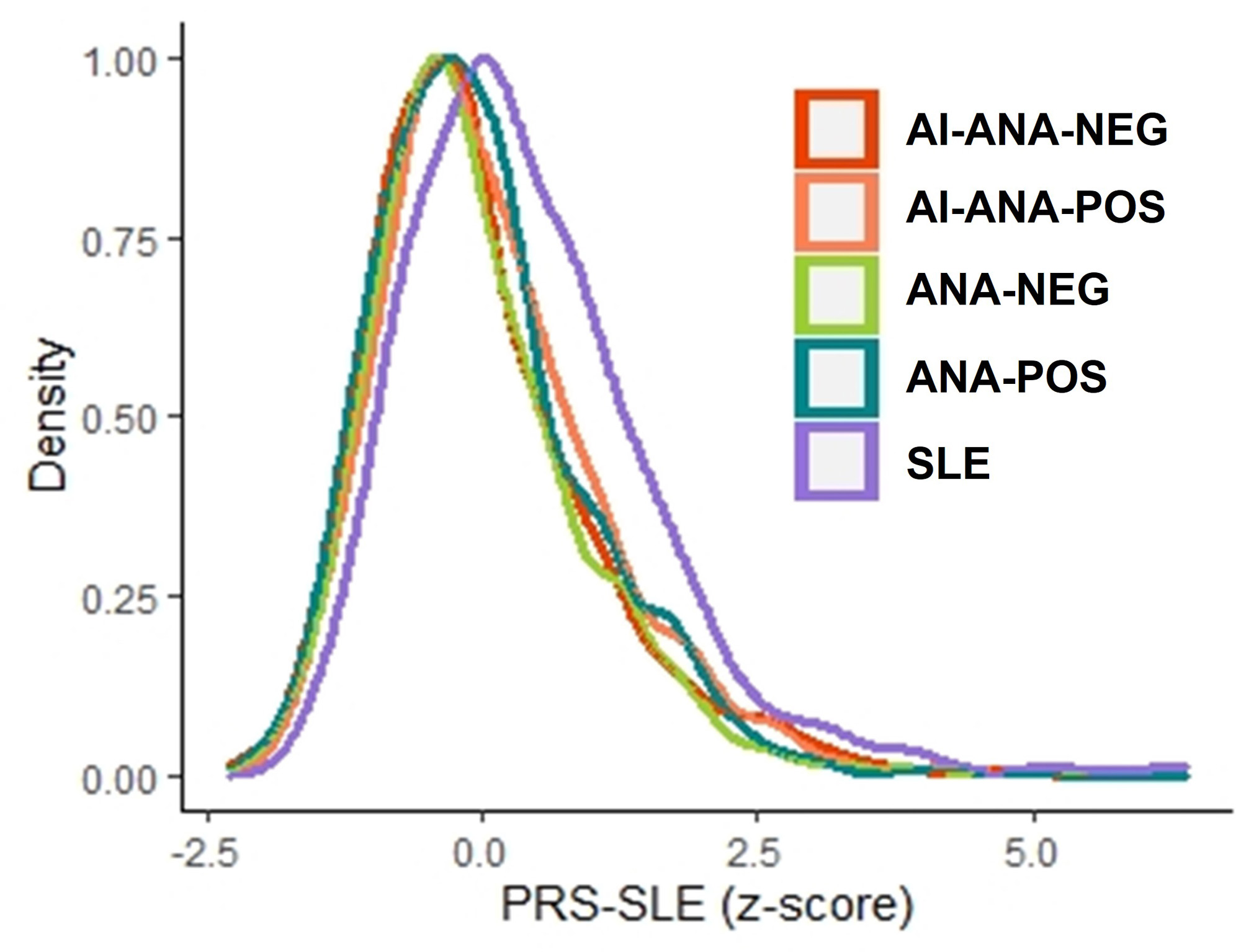Session Information
Date: Sunday, November 12, 2023
Title: (0543–0581) SLE – Diagnosis, Manifestations, & Outcomes Poster I
Session Type: Poster Session A
Session Time: 9:00AM-11:00AM
Background/Purpose: A positive ANA (ANA-POS) test is present in almost all patients with SLE and is also frequently present in other autoimmune (AI) diseases and in the general population. Genetic factors play an important role in the risk for SLE and a polygenic risk score for SLE (PRSSLE) is significantly different in patients with SLE compared to controls. However, several studies have reported immunologic findings or clinical features of incomplete lupus in ANA-POS patients without SLE, raising concern for increased genetic risk of SLE in these patients. Thus, a clinically important question is whether a PRSSLE differs among patients with SLE and individuals without SLE who have a positive ANA test.
Methods: We built a PRSSLE using a Bayesian framework with continuous shrinkage using summary data from the largest SLE genome-wide association analysis (GWAS) in individuals of European ancestry. Then, we calculated the PRSSLE in individuals who were tested for ANA as part of their clinical care and had genome-wide interrogation in BioVU – a biobank that links de-identified genetic and electronic health record data at Vanderbilt. We defined 5 different groups: patients with SLE (SLE), patients with other AI diseases who had a positive (AI-ANA-POS) or a negative (AI-ANA-NEG) ANA test, and individuals without an AI disease who had a positive (ANA-POS) or a negative (ANA-NEG) ANA test. A positive ANA was defined as a titer of 1:80 or higher. The PRSSLE was standardized and compared between patients with SLE and the other 4 groups. A P-value ≤ 0.0125 (0.05/ 4 comparisons) was considered significant. To test the ability of the PRSSLE to discriminate patients with SLE among those with a positive ANA test, we selected individuals (n=4,086) with a positive ANA (SLE, ANA-POS and AI-ANA-POS), and trained two predictive models (PRSSLE alone, and PRSSLE, sex, and age) using a 70% of the sample as training set. Then, we calculated the area under the curve (AUC) of the Receiver Operating Characteristic (ROC) curve in the remaining sample (testing set). Continuous variables were analyzed using Wilcoxon rank-sum test.
Results: We studied 10,032 individuals of European ancestry with ANA results. Patients with SLE had a higher proportion of female patients and were younger compared to the other groups (all P< 0.0125) (Table). The PRSSLE was higher is the SLE group compared to all other groups: AI-ANA-POS (P=1.8E-11), ANA-POS (P=3.7E-20), AI-ANA-NEG (P=1.5E-21), and ANA-NEG (P=1.2E-28). (Figure and Table). The PRSSLE discriminated patients with SLE from those with a positive ANA test (AUC = 0.61, 95%CI [0.57, 0.66]) and the inclusion of age and sex resulted in a higher AUC (0.66, 95%CI [0.62, 0.70]) (P=0.02)
Conclusion: Patients with SLE have a higher PRSSLE compared to individuals with a positive ANA test. The PRSSLE had a modest discriminative ability to distinguish patients with SLE among those with a positive ANA result, and this increased when age and sex were also included in the model.
To cite this abstract in AMA style:
Karakoc G, Liu G, Zanussi J, Chung C, Gamboa J, Mosley J, Cox N, Stein C, Kawai V. A Polygenic Risk Score for Systemic Lupus Erythematosus (SLE) Discriminates Between Patients with Lupus and Individuals Without Lupus and a Positive Antinuclear Antibody Test [abstract]. Arthritis Rheumatol. 2023; 75 (suppl 9). https://acrabstracts.org/abstract/a-polygenic-risk-score-for-systemic-lupus-erythematosus-sle-discriminates-between-patients-with-lupus-and-individuals-without-lupus-and-a-positive-antinuclear-antibody-test/. Accessed .« Back to ACR Convergence 2023
ACR Meeting Abstracts - https://acrabstracts.org/abstract/a-polygenic-risk-score-for-systemic-lupus-erythematosus-sle-discriminates-between-patients-with-lupus-and-individuals-without-lupus-and-a-positive-antinuclear-antibody-test/


